Select Language: tiếng Việt
US - Vietnam conflict
France’s campaign to remain a colonial power in Vietnam came to end when French forces, which included large numbers of Indochinese and Foreign Legion troops, the latter including former members of Nazi Germany’s SS units, were routed at the battle of Dien Bien Phu in May 1954.
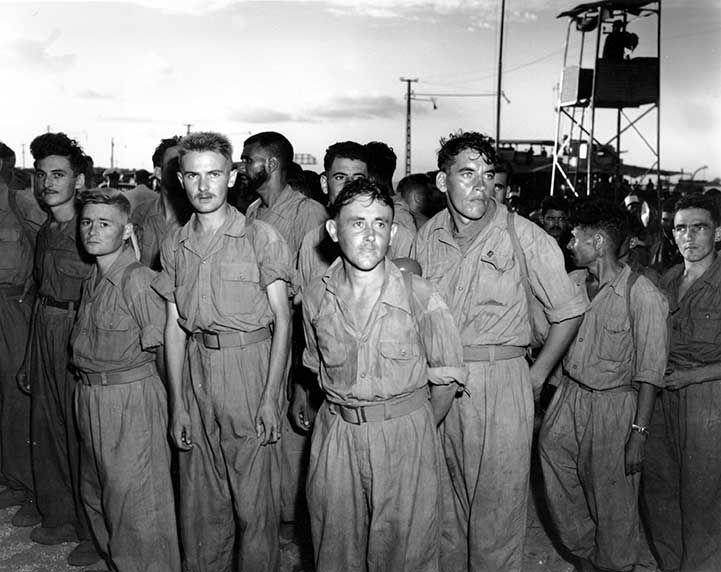
French prisoners of war arrive in Hanoi, Indochina, after release by Viet Minh captors on Aug. 25, 1954 during the Indochina War. The soldiers, freed at Viet Tri in the prisoner exchange, were brought down the Red River by boat to Vietnam's capital city for evacuation. (AP Photo)
In the Geneva conference that followed the battle, it would have been reasonable for the victorious Viet Minh to expect to dictate the terms of peace. However, the US, which by then saw the world as a battle ground between pro and anti-communist forces, made it known that it was loath to allow the whole of Vietnam to come under the control of Ho Chi Minh’s communist regime.
The looming threat of a US military intervention in Vietnam therefore hung heavy over the Geneva peace conference, prompting Russia and China to pressure Vietnam to placate the US by creating a non-communist South Vietnamese state.
The Viet Minh, feeling they had no choice, reluctantly agreed to the partition of the country along the 17th parallel. The one plus point from the point of view of the Viet Minh was that the Geneva Accords promised that elections on re-unification would be held in 1956.
After the partition, nearly one million people moved to the South to avoid being ruled by Ho’s communist regime. The US actively encouraged this migration, spreading propaganda about the dangers of living under communist rule and laying on transportation for those wanting to make an exit from North Vietnam.
This population of refugees, which included 600,000 Catholics, was anti-communist and their presence in the South gave the new US-backed ruler of South Vietnam, Ngo Diem, a guaranteed support base. It was also from this population that Diem drew his South Vietnam army and police officers.
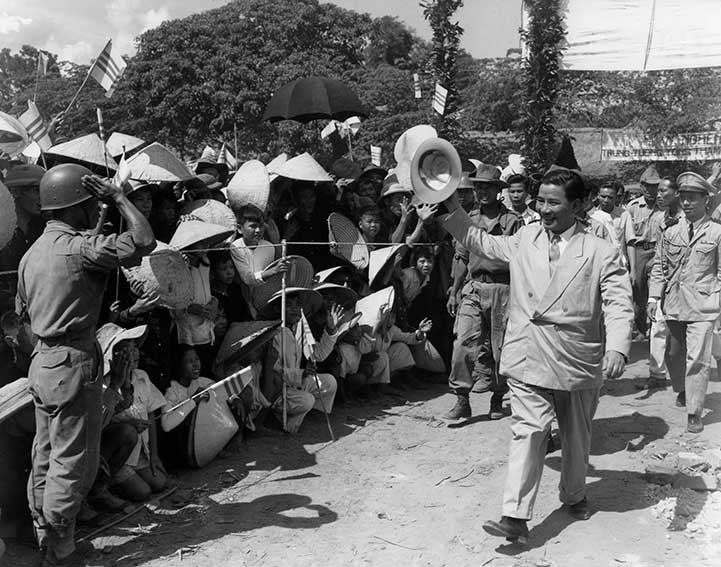
South Vietnam Premier Ngo Dinh Diem, winner in the recent battle for power at Saigon, exchanges greetings with villagers during a recent visit to the Indochina coastal town of Binh Dinh, Vietnam on June 12, 1955. Diem appears well on his way to ousting the French from control in South Vietnam, strategic Southeast Asia area coveted by the communists. (AP Photo/Fred Waters )
It is noteworthy that the 1954 flow of refugees from the North was not followed by a secondary wave of rank-and-file members of the society. Although land reform in the North had undoubtedly caused great suffering among affluent sections of society, it had also brought improvements to the lives of others and had considerable support.
Meanwhile, in accordance with the Geneva Accords, about 150,000 South Vietnamese members of the Viet Minh moved to the North, where they were obliged to stay until the elections on reunification were held in 1956. However many South Vietnamese members of the Viet Minh remained in the South due to fears that the elections would never be held and that they would therefore have to take up arms to fight for reunification.
In the event, as the Viet Minh had feared, the promised elections of 1956 were never held. Diem, the Southern ruler, refused to acknowledge the validity of the promise made in the Geneva Accords and simply ignored requests to hold the elections. For its part the US, which was also keen for elections to be avoided, spent billions of dollars supporting Diem’s regime in a bid to turn the new country of South Vietnam into a strong, anti-communist state.
In the years that followed the Geneva Accords, conflict broke out between Diem’s regime and a South Vietnamese anti-Diem alliance headed up by communists. This alliance was officially called the National Liberation Front or NLF, but was also known by the pejorative term the ‘Viet Cong’.
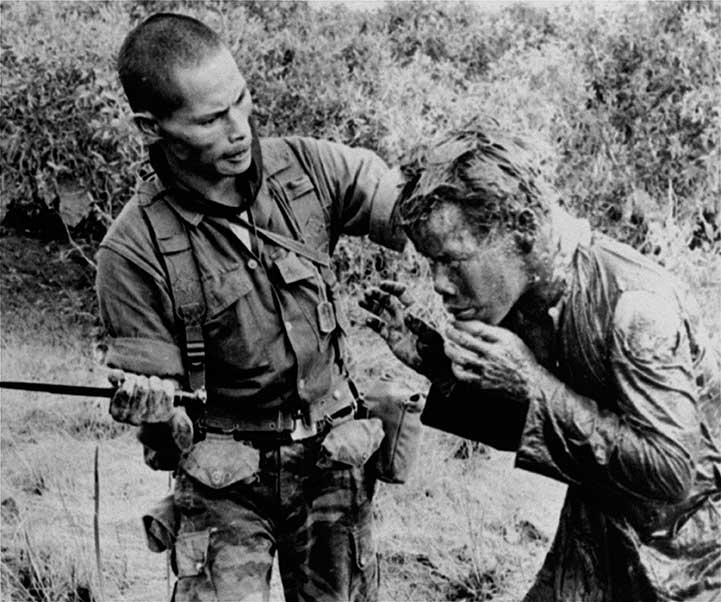
A South Vietnamese ranger uses the end of a dagger to administer punishment to a South Vietnamese farmer for allegedly supplying government troops with wrong information on Communist guerrillas.
As the conflict raged, the US poured in assistance for the South Vietnam regime in the form of money, training and weapons. But despite the aid, Diem’s government and the equally corrupt and inept South Vietnamese governments that held power after Diem’s assassination in 1963 continued to lack credibility among much of the population of South Vietnam and to suffer defeats on the battle field.
As a result, in 1965 the US ratcheted up its support further by landing American troops in South Vietnam. At the same time Washington ordered bombing raids to be made on Hanoi to dissuade North Vietnam’s leaders from supporting the NLF. By the mid-1960s then, the US was at war in Vietnam.
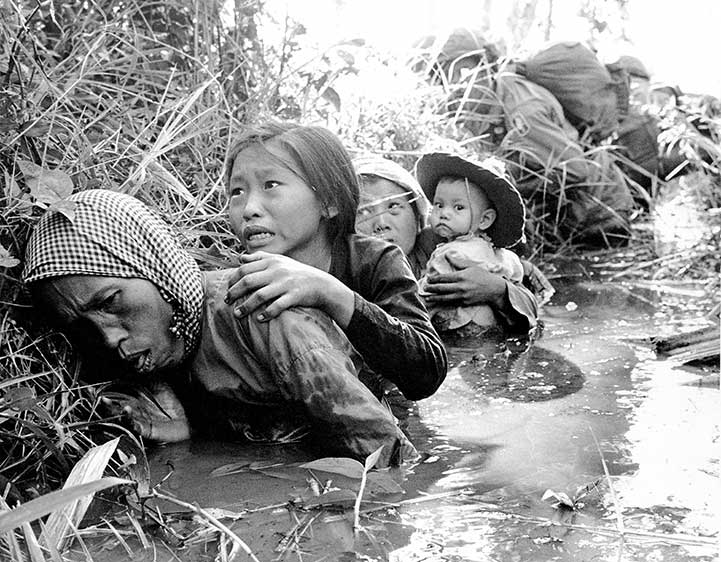
Women and children crouch in a muddy canal as they take cover from intense Viet Cong fire at Bao Trai, about 20 miles west of Saigon.
US troops remained in Vietnam until 1973, when they withdrew as part of an attempt to hand the prime responsibility for fending off communism in South Vietnam back the Saigon regime and its army. This scheme, known as ‘Vietnamization’, was to prove relatively short-lived. Although the NLF had been greatly weakened by the large scale offensive it mounted during the Vietnamese New Year (called ‘Tet’) of 1968, its ally, the NVA, was still strong. Without US boots on the ground to support it, the Army of the Republic of Vietnam (ARVN – South Vietnam’s army) struggled to hold the North Vietnam Army (NVA) in check.
By early 1975 the ARVN was crumbling in the face of NVA advances and on April 30th 1975, NVA tanks smashed through the gates of the Presidential Palace in Saigon, marking the end of the war and the start of communist rule over the whole of Vietnam.
Though there is some consensus among historians and Vietnamese people about the exploitative nature and negative impact of France’s occupation of Vietnam the same could not be said of the causes of the US war. To this day, the US war and its aftermath remains a polarizing subject among Vietnamese people.
The official US position at the time of the war was that North Vietnam’s communist party, being part of a wider communist movement headed up by leaders in Moscow, was determined to play its part in spreading international communism by imposing itself on an independent-minded South Vietnam.
This theory, which is also espoused by many of those who fled South Vietnam after the communist victory, posits that the population South of the 17th parallel was strongly opposed to communist rule and needed US assistance to fend off Ho Chi Minh and his forces. Some of those Vietnamese people who back this notion, most notably those in America, have expressed deep anger with the US for ‘deserting’ them in 1975.
An alternative view is that significant sections of the South Vietnamese population, especially the rural poor, had supported the communist-dominated Viet Minh during the war against France and continued to sympathise with the communists after that war.
Impressed by the social gains made by the Viet Minh on behalf of poor people during the French war and appalled at the new, brutal, US-backed regime in South Vietnam, many rural South Vietnamese fought tooth-and-nail to oust the South Vietnam Government and their US backers and usher in a communist government.
According to this standpoint, the North, far from being keen to invade the South, staved off becoming involved in the conflict between the US-backed South Vietnam regime and the South’s National Liberation Front (NLF also known as the Viet Cong) for as long as it could for fear of triggering a US invasion. However, say the proponents of this view, the ever increasing US military involvement combined with the desperate situation of the NLF in the South eventually persuaded Hanoi to send troops South.
Due to the controversial nature of this topic, the Anchored in London project team has merely provided a brief summary of the events that took place in the run-up to and during the US-Vietnam conflict. We are not supporting either side; rather we are leaving it for others to make up their own minds.
